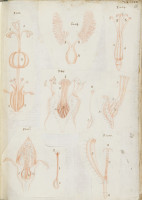Flower reproductive organs
Date
1675
Creator
Unknown, Engraver
After
Marcello Malpighi (1628 - 1694, Italian) , Biologist
Object type
Library reference
54269
Material
Dimensions
height (page): 362 mm
width (page): 231mm
height (plate): 310mm
width (plate): 217mm
width (page): 231mm
height (plate): 310mm
width (plate): 217mm
Subject
Description
Sectional studies of the pistil and stamen of various plant species’ flowers viewed under magnification, including:
Figure 202 [upper left]: Cacti, Cactaceae, referred to by Malpighi as Chamaecito.
Figure 203 [upper centre]: Wheat, Triticum, referred to as Tritico.
Figure 204 [upper right]: Flax, Linum usitatissimum, referred to as Lino.
Figure 205 [centre]: Bramble tree, Rubus, and rose, Rosa, referred to as Rubo canino and Rosis respectively.
Figure 206 [lower left]: Peat, Sphagnum, and quince, Cydonia vulgaris, referred to as Piro and Malo Cydonia respectively.
Figure 207 [lower right]: Various Asteraceae plants.
Inscribed: ‘TAB. XXXIII’ in the top right-hand corner.
Table 33 from Marcello Malpighi's Anatome plantarum; cui subjungitur Appendix […] (1675).
Marcello Malpighi (1628-1694), Italian biologist and physician, was elected a Fellow of the Royal Society in 1669.
Figure 202 [upper left]: Cacti, Cactaceae, referred to by Malpighi as Chamaecito.
Figure 203 [upper centre]: Wheat, Triticum, referred to as Tritico.
Figure 204 [upper right]: Flax, Linum usitatissimum, referred to as Lino.
Figure 205 [centre]: Bramble tree, Rubus, and rose, Rosa, referred to as Rubo canino and Rosis respectively.
Figure 206 [lower left]: Peat, Sphagnum, and quince, Cydonia vulgaris, referred to as Piro and Malo Cydonia respectively.
Figure 207 [lower right]: Various Asteraceae plants.
Inscribed: ‘TAB. XXXIII’ in the top right-hand corner.
Table 33 from Marcello Malpighi's Anatome plantarum; cui subjungitur Appendix […] (1675).
Marcello Malpighi (1628-1694), Italian biologist and physician, was elected a Fellow of the Royal Society in 1669.
Object history
Anatome Plantarum was a much-anticipated work and, along with Nehemiah Grew FRS (1641-1712), earned Malpighi acclaim as founder of the microscopic study of plant anatomy.
His research was encouraged and supervised by the Royal Society, as evidenced by correspondence between him and the then-Secretary, Henry Oldenburg FRS (1619-1677) in the 1660s and 1670s [MS/103/1]. An abstracted version of his work in this area was first read at a Society meeting on 7 December 1671 [JBO/4, pp.216-217]. The full manuscript of Anatome Plantarum, together with the frontispiece artwork and these plates, was received and read on 28 January 1674/75 [MS/103/1-2].
It was ordered for printing by the Society’s printer John Martin in June 1675 [CMO/1/221]. The published work consists of the text of Anatome Plantarum, De ovo incubato, and 61 plates illustrating each [54 and 7 respectively]. A second part was sent by Malpighi to the Society in 1678 and published in 1679 as Anatomes plantarum pars altera [54271].
His research was encouraged and supervised by the Royal Society, as evidenced by correspondence between him and the then-Secretary, Henry Oldenburg FRS (1619-1677) in the 1660s and 1670s [MS/103/1]. An abstracted version of his work in this area was first read at a Society meeting on 7 December 1671 [JBO/4, pp.216-217]. The full manuscript of Anatome Plantarum, together with the frontispiece artwork and these plates, was received and read on 28 January 1674/75 [MS/103/1-2].
It was ordered for printing by the Society’s printer John Martin in June 1675 [CMO/1/221]. The published work consists of the text of Anatome Plantarum, De ovo incubato, and 61 plates illustrating each [54 and 7 respectively]. A second part was sent by Malpighi to the Society in 1678 and published in 1679 as Anatomes plantarum pars altera [54271].
Associated place
